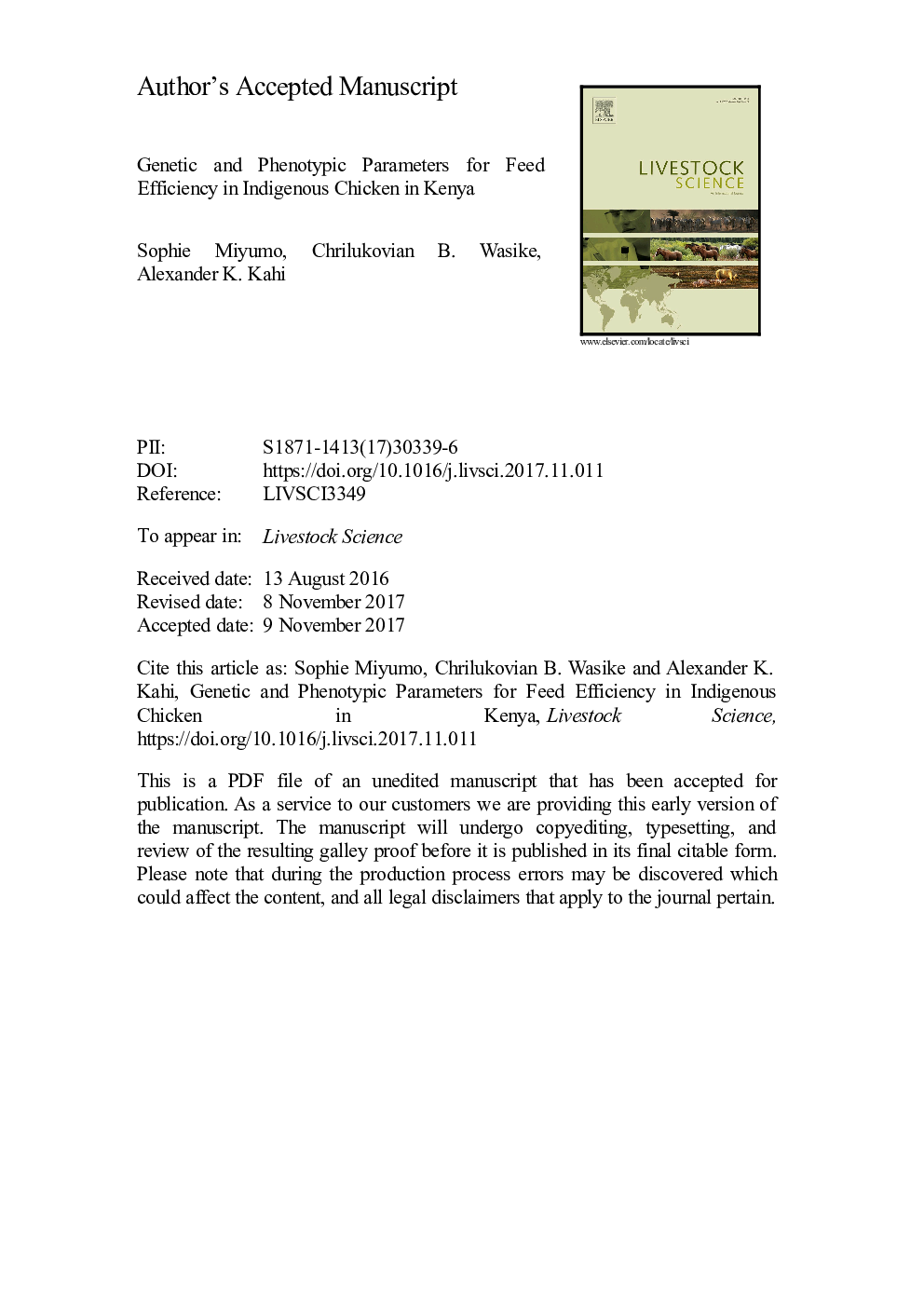| کد مقاله | کد نشریه | سال انتشار | مقاله انگلیسی | نسخه تمام متن |
|---|---|---|---|---|
| 8502068 | 1553925 | 2018 | 40 صفحه PDF | دانلود رایگان |
عنوان انگلیسی مقاله ISI
Genetic and phenotypic parameters for feed efficiency in indigenous chicken in Kenya
ترجمه فارسی عنوان
پارامترهای ژنتیکی و فنوتیپی برای بازده خوراک در مرغ بومی در کنیا
دانلود مقاله + سفارش ترجمه
دانلود مقاله ISI انگلیسی
رایگان برای ایرانیان
کلمات کلیدی
مرغ بومی، راندمان خوراک، پارامترهای ژنتیکی، مدل رگرسیون تصادفی چندجملهای لژاندر،
موضوعات مرتبط
علوم زیستی و بیوفناوری
علوم کشاورزی و بیولوژیک
علوم دامی و جانورشناسی
چکیده انگلیسی
This study aims to determine the genetic and phenotypic parameters of net feed efficiency (NFE) traits namely Residual feed intake (RFI), residual gain (RG), and residual intake and gain (RIG) along the growth curve of indigenous chicken in Kenya. Feed intake and body weight data was collected on 107 experimental birds on a daily and weekly basis, respectively from 77 days to 140 days of age. Random regression sire model was used for analysis, fitting Legendre polynomials as basis function. Sex, hatch group and interaction between sex and cluster constituted fixed effects in the model while additive genetic and permanent environmental effects were fitted as random variables. A heteroscedastic residual variance was modelled by grouping the test period into nine classes. The orders of polynomial fit for additive genetic and permanent environmental effects in the model were 4 and 5; 3 and 4; and 5 and 5; for RFI, RG and RIG, respectively. The additive genetic variances for RFI and RG were higher at the beginning of the trajectory but declined as the test period progressed while their respective phenotypic and permanent environment variances increased with age. Consequently, moderate (0.34) and high (0.77) heritability estimates for RFI and RG, respectively, were observed during the early test period and thereafter decreased to 0.03 for RFI and 0.01 for RG. Additive genetic variance for RIG increased across the test period while phenotypic and permanent environment variances declined. This resulted in high estimates of heritability and permanent environmental variance as a proportion of phenotypic variance of 0.69 and 0.98, respectively, at the extremes of the trajectory. At mid-point of test period, low estimates of heritability and permanent environmental variance as a proportion of phenotypic variance of 0.13 and 0.19, respectively were observed. The heritability estimates indicate possible selective breeding for NFE given the moderate estimates (0.23-0.34) for RFI, moderate to high estimates (0.30-0.77) for RG and high estimates (0.49-0.98) for RIG. However, caution has to be taken when selecting for RG and RIG given the extreme heritability estimates resulting from statistical and biological factors. Genetic correlations were high to moderate and positive (0.99 to 0.32) between records at early and mid-ages (77-105 days), but high and negative (â0.99 to â0.45) between early (77 days) and late ages (112-140 days). Selection for NFE at growth inflection point (77 days) would result in a favourable correlated response at point of maximum growth (105 days) but would be associated with unfavourable response at point of asymptotic growth (140 days) as birds are approaching sexual maturity. Given the high standard errors for the genetic parameters estimates in this study, there is need for further analyses prior to selection for feed efficiency indigenous chicken.
ناشر
Database: Elsevier - ScienceDirect (ساینس دایرکت)
Journal: Livestock Science - Volume 207, January 2018, Pages 91-97
Journal: Livestock Science - Volume 207, January 2018, Pages 91-97
نویسندگان
Sophie Miyumo, Chrilukovian B. Wasike, Alexander K. Kahi,
